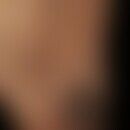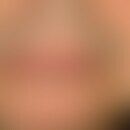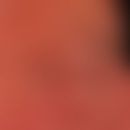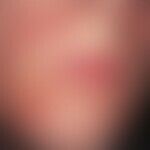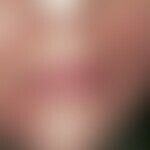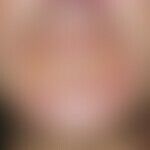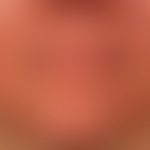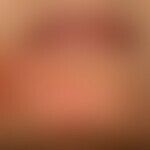Synonym(s)
HistoryThis section has been translated automatically.
Frumess & Lewis 1957; Mihan & Ayres 1964.
DefinitionThis section has been translated automatically.
Dermatitis limited to the perioral facial skin, usually chronically persistent or chronically recurrent, with extensive erythema, red disseminated follicular papules, pustules, plaques, accompanied by itching/burning or painful dermatitis, which occurs primarily in "cosmetic-conscious" young women.
You might also be interested in
Occurrence/EpidemiologyThis section has been translated automatically.
This now common clinical picture, which is related to rosacea, has only emerged in the last 3 decades and is probably related to the care habits that have been common since then.
EtiopathogenesisThis section has been translated automatically.
Unknown.
A seborrheic constitution, gastrointestinal disorders, sunlight, ovulation inhibitors, degenerative-toxic contact dermatitis or sequelae of prolonged local corticosteroid therapy are discussed as triggering factors. Candida species and various bacteria, such as fusiform spirillae or rod bacteria, have also been attributed a causative role. In most cases, however, there is a pronounced misuse of skin care cosmetics (which are often stored incorrectly and too warm!) and/or of creams/ointments containing glucocorticoids, which are applied uncontrollably to banal inflammations of the facial skin.
ManifestationThis section has been translated automatically.
Occurs mainly in women between the ages of 20 and 45. Only rarely are men or young children affected. The latter usually receive the same "intensive" local therapy as their worried mothers.
LocalizationThis section has been translated automatically.
Chin, nasolabial folds, lateral parts of the mouth, forehead, periorbital, possibly spreading to the entire face, the lateral parts of the neck and the retroauricular area.
The perioral free zone is typical (the vellus hairs that are affected in perioral dermatitis are missing here!)
Note! The disease can also (more rarely) occur in isolation in the eyelid and periorbital area as "periorbital dermatitis" (see eczema, eyelid eczema below).
ClinicThis section has been translated automatically.
In the reddish, slightly swollen and scaly skin of the perioral region, there are disseminated or grouped, 0.2-0.4 cm large, red, scaly follicular papules, papulovesicles and papulopustules. The skin lesions are blurred to the lateral parts of the face with leaking follicular papules and scaly erythema. Over the entire inflammatory area there is usually a distinct itching or sometimes an unbearable feeling of tension which can only be alleviated by applying creams (Circulus vitiosus especially if these skin care creams contain glucocorticoids).
A characteristic feature is the absence of a skin zone directly bordering on the lip red which results in a typical multizone picture with free lip red, free perioral border and a dermatitis ring of varying width.
The clinical picture is variable. There are often nodules in the nasolabial folds as well as in the corners of the eye.
Special form: Lupoid perioral dermatitis.
TherapyThis section has been translated automatically.
"Any successful therapeutic approach is based on weaning patients off their previous (beloved) care habits". This includes:
Discontinuation of all cosmetics and previous ointments and above all all glucocorticoid externals!
Cleansing the face without using any other chemicals.
The careful use of microfiber cloths, e.g. Claroderm, has proven effective here; this can be used to remove ointment residues.
If additional cleansing of the face is necessary, use a syndet sparingly (e.g. Dermowas or Sebamed liquid).
Briefly dab the face with a clean towel (do not rub!).
Avoid perfumes in cosmetics, detergents and room sprays.
Black tea compresses have proven effective in soothing irritated skin.
External therapyThis section has been translated automatically.
As a "zero therapy" is usually not feasible, mild anti-inflammatory topicals should be used:
- Apply a thin layer of Leukichtan gel (active ingredient: sodium bituminosulphate) in the evening and apply a non-perfumed moisturizing cream or gel in the morning.
- In stubborn cases, an Ichthyol® ointment containing zinc can also be used.
- Alternatively: Skinoren gel. Caution! Check compatibility first!
- If the face feels very tight, apply black tea compresses (allow 2-3 bags of black tea to infuse for about 10-15 minutes; after cooling, leave to act on the face for 10-15 minutes using a linen cloth); alternatively: compresses with synthetic tanning agents (e.g. Tannosynt, Tannolact).
- Therapeutic success can also be achieved by strictly "drying out" the skin: after cleansing the facial skin in the morning (see above), apply a solution containing erythromycin (e.g. R086, Aknemycin solution, Zineryt). Alternatively, a 0.5-2% metronidazole gel (e.g. Metrogel) can be applied instead of erythromycin solutions.
- Cover the inflamed facial skin (e.g. Unifiance cream make-up, Lutsine make-up stick).
- In the case of long-term steroid abuse, it may be necessary to "phase out" the steroid externa with the temporary use of low-concentration steroids(0.1-0.5% hydrocortisone cream as a formulation or as a finished product, e.g. Hydrogalen) in order to alleviate the withdrawal symptoms (interpreted by patients as treatment failure).
Internal therapyThis section has been translated automatically.
In severe cases (especially with pre-treatment with steroid-containing topicals):
Doxycycline (e.g. Doxycycline Stada) 2 times/day 100 mg p.o. or
Minocycline (e.g. clinomycin) 2 times/day 50 mg p.o.
or alternatively macrolides in case of allergies
Clarithromycin (e.g. Klacid) 2 times/day 250 mg p.o. or
Erythromycin (e.g. Infectomycin 600 juice) 2 times/day 7.5ml
In addition, sodium bituminosulfonates (e.g. Ichthraletten 3 times/day 2 drg. 1st to 2nd week, then 3 times/day 1 drg. p.o.).
LiteratureThis section has been translated automatically.
- Fritsch P et al (1989) Perioral dermatitis. Dermatologist 40: 475-479
- Frumess GM, Lewis HM (1957) Light sensitive seborrhoea. Arch Dermatol 75: 245-248
- Hafeez ZH (2003) Perioral dermatitis: an update. Int J Dermatol 42: 514-517
- Kalkoff KW et al. (1977) On the pathogenesis of perioral dermatitis. Dermatologist 28: 74
- Nolting S et al (1977) Origin and significance of perioral dermatitis. Münch Med weekly 110: 49
- Takiwaki H et al (2003) Differences between intrafollicular microorganism profiles in perioral and seborrhoeic dermatitis. Clin Exp Dermatol 28: 531-534
- Tempark T et al (2014) Perioral dermatitis: a review of the condition with special attention to treatment options. At J Clin Dermatol 15:101-113
- Wagner G et al (2014) Childhood granulomatous periorificial dermatitis. Dermatologist 65:903-907
Incoming links (19)
Cheilitis simplex; Demodex folliculitis; Dermatitis periorale granulomatous of childhood; Dermatitis, rosacea-like; Erythromycin solution ethanol containing 0,5/1/2 or 4 % (nrf 11.78.); Glucorticosteroids topical; Ichthyol mixing paste 0.5-2.0%; Light sensitive seborrhoids; Lupoid perioral dermatitis; Maskne; ... Show allOutgoing links (6)
Doxycycline; Erythromycin solution ethanol containing 0,5/1/2 or 4 % (nrf 11.78.); Eyelid dermatitis (overview); Hydrocortisone cream 0.5-2.0% (w/o); Lupoid perioral dermatitis; Minocycline;Disclaimer
Please ask your physician for a reliable diagnosis. This website is only meant as a reference.
